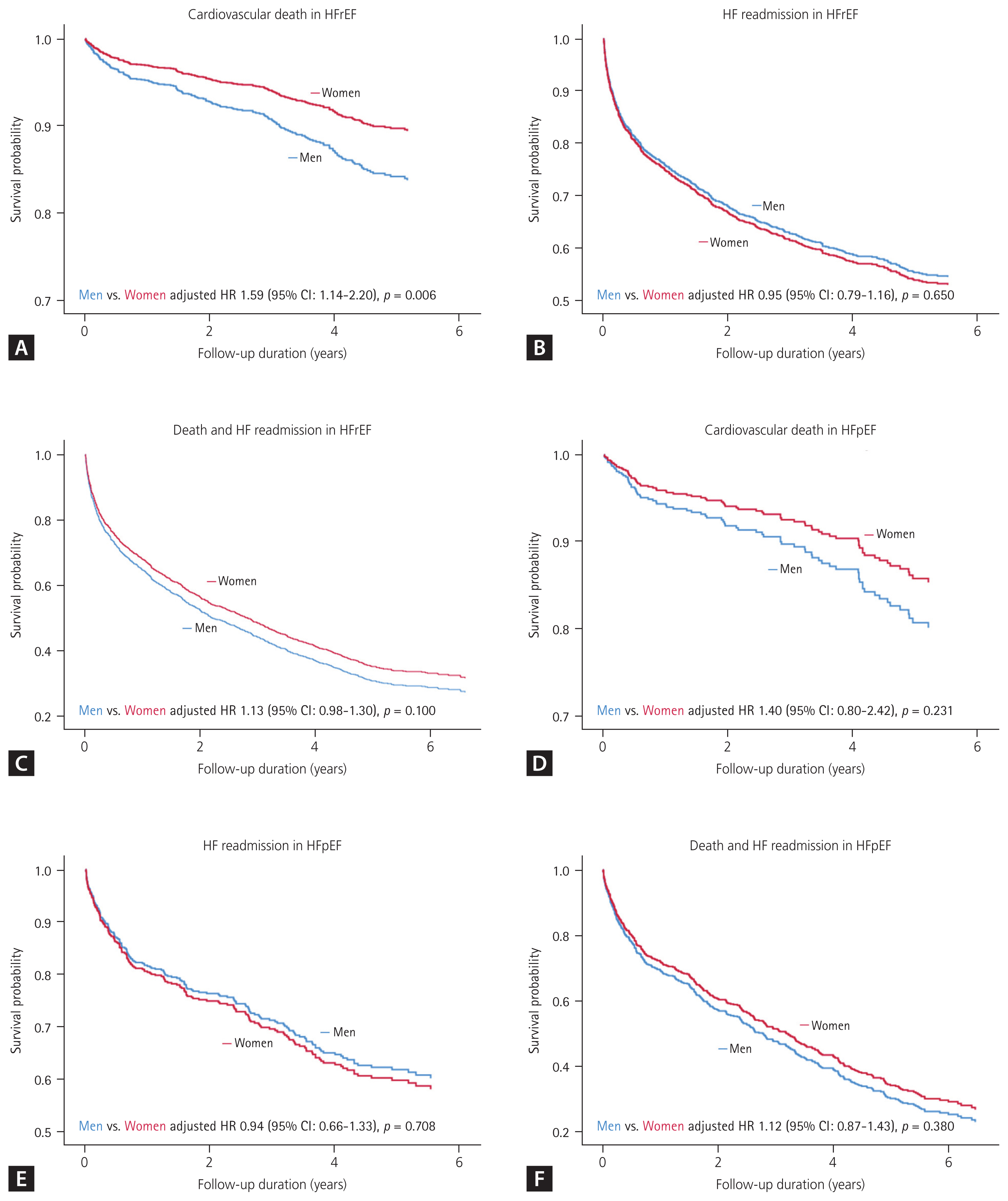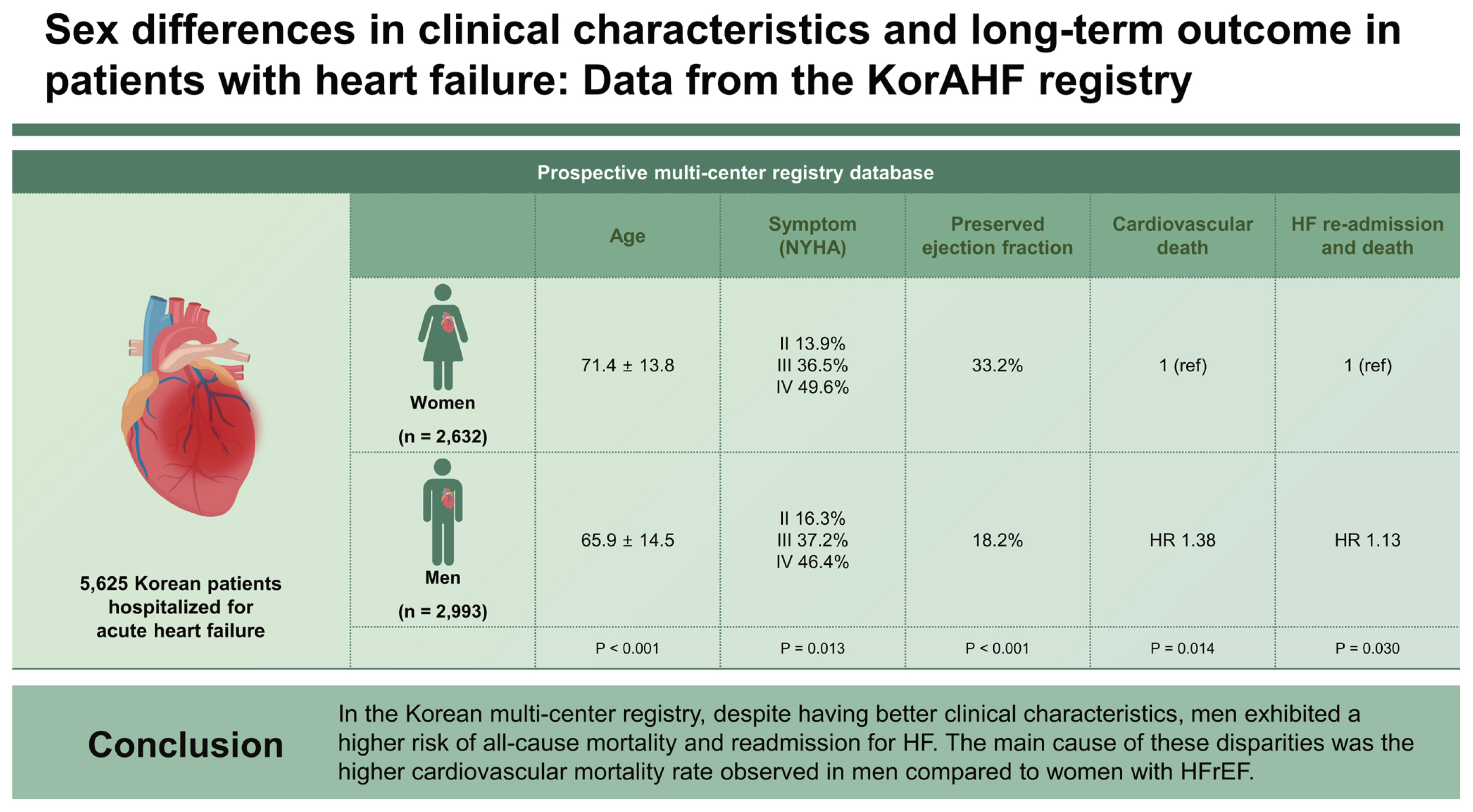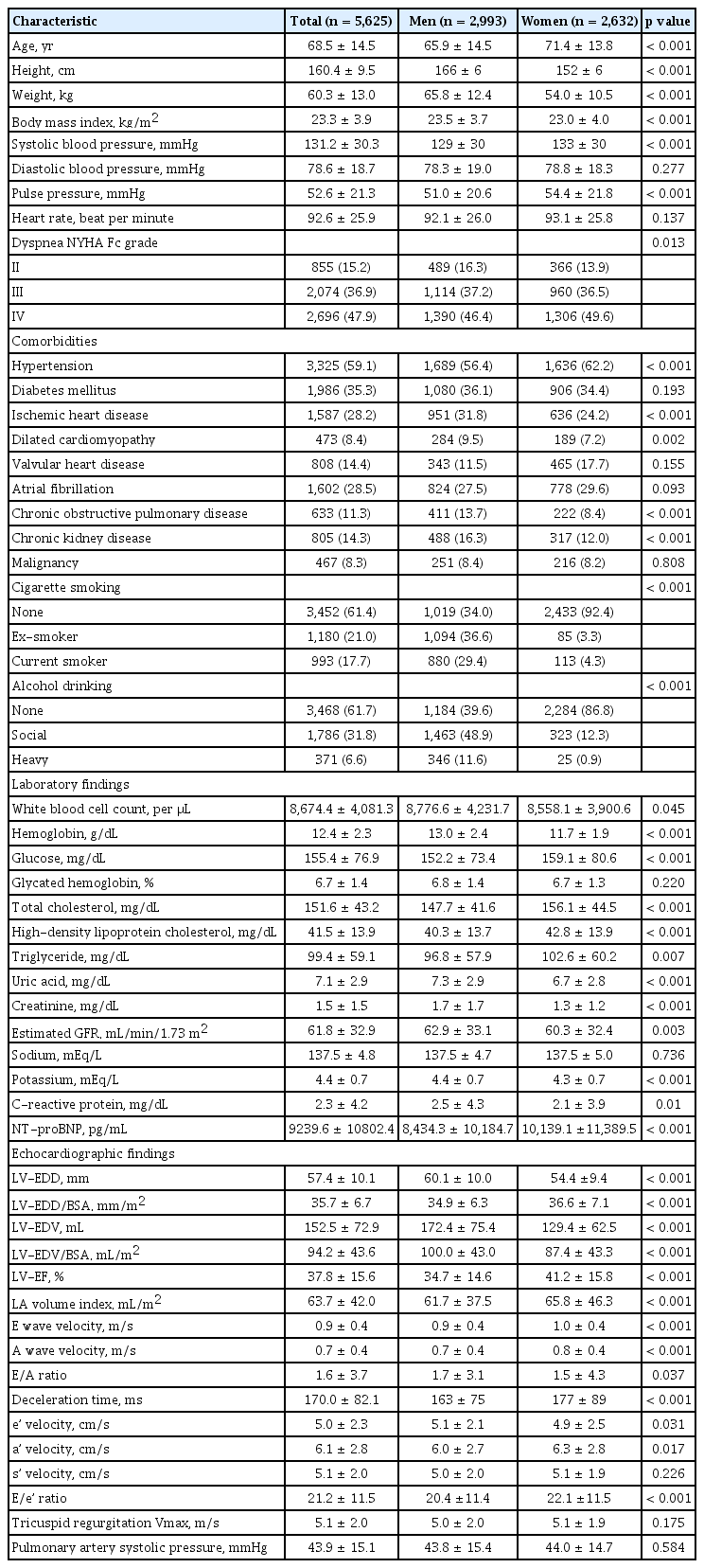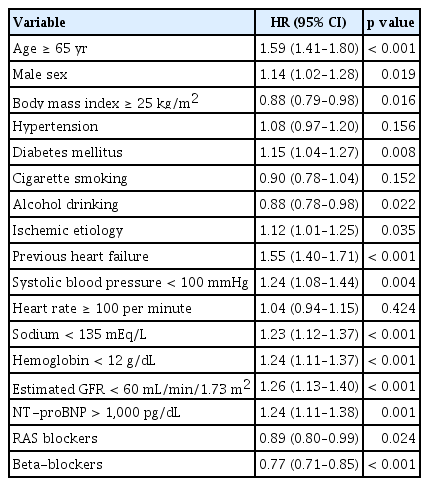Sex differences in clinical characteristics and long-term outcome in patients with heart failure: data from the KorAHF registry
Article information
Abstract
Background/Aims
Sex differences in the prognosis of heart failure (HF) have yielded inconsistent results, and data from Asian populations are even rare. This study aimed to investigate sex differences in clinical characteristics and long-term prognosis among Korean patients with HF.
Methods
A total of 5,625 Korean patients hospitalized for acute HF were analyzed using a prospective multi-center registry database. Baseline clinical characteristics and long-term outcomes including HF readmission and death were compared between sexes.
Results
Women were older than men and had worse symptoms with higher N-terminal pro B-type natriuretic peptide levels. Women had a significantly higher proportion of HF with preserved ejection fraction (HFpEF). There were no significant differences in in-hospital mortality and rate of guideline-directed medical therapies in men and women. During median follow-up of 3.4 years, cardiovascular death (adjusted hazard ratio [HR], 1.38; 95% confidence interval [CI], 1.07–1.78; p = 0.014), and composite outcomes of death and HF readmission (adjusted HR, 1.13; 95% CI, 1.01–1.27; p = 0.030) were significantly higher in men than women. When evaluating heart failure with reduced ejection fraction (HFrEF) and HFpEF separately, men were an independent risk factor of cardiovascular death in patients with HFrEF. Clinical outcome was not different between sexes in HFpEF.
Conclusions
In the Korean multi-center registry, despite having better clinical characteristics, men exhibited a higher risk of all-cause mortality and readmission for HF. The main cause of these disparities was the higher cardiovascular mortality rate observed in men compared to women with HFrEF.
INTRODUCTION
Population aging is a global phenomenon, and heart failure (HF) is a predominant disease of the elderly with an increased prevalence in old age. As a result, the absolute number of patients with HF is constantly growing [1], which constitutes a significant portion of the global disease burden [2].
Efforts have been made to understand the difference between men and women in various cardiovascular diseases and apply this knowledge to diagnosis and treatment. HF is one of the representative cardiovascular diseases that exhibit significant sex differences [3]. Several differences between men and women have been reported in HF, such as prevalence, risk factors, pathophysiology, and clinical presentation [3–6]. However, the findings regarding sex differences in HF prognosis remain inconclusive [7–9]. Some studies reported better survival in women with HF compared to men [7,10–13], while others demonstrated similar rates of mortality following admission for acute HF between men and women [8,14]. Meanwhile, a Japanese observational study on HF with preserved ejection fraction (HFpEF) demonstrated that elderly women were independently associated with worse clinical outcomes [15]. Additionally, research on the prognosis of HF based on sex has primarily been carried out in Western societies, with insufficient data on outcomes for Asians. Previously, we published data on the sex-specific prognosis of patients with acute HF using nationwide registry data [16]. In this study of 2,572 patients hospitalized due to HF, there was no sex difference in long-term clinical outcomes. However, this data was from the registry constructed between 2004 and 2009. It does not reflect more recent contemporary clinical practice.
Identifying differences in the clinical features and prognosis of HF between men and women can enhance our understanding of the disease, and improve its management and prognosis of HF. It is also crucial to gather more data specific to the Asian population. Therefore, the objective of this study was to assess sex differences in characteristics and long-term clinical outcomes in Korean patients with HF, using a prospective cohort registry.
METHODS
Study population
The Korean Acute Heart Failure (KorAHF) registry is a prospective and multi-center cohort study conducted in Korea [17]. Briefly, patients who had symptoms or signs of HF and met one of the following criteria were consecutively enrolled on admission for acute decompensated HF: 1) pulmonary congestion or 2) objective findings of left ventricular (LV) systolic dysfunction or structural heart disease. Lung congestion was defined as ‘congestion’ on a chest X-ray or as rales on physical examination. Structural heart disease was defined as heart disease that involve cardiac valves, walls, chambers, or walls. There are no exclusion criteria. From March 2011 to February 2014, 5,625 patients were enrolled in 10 tertiary university hospitals in Korea. The study was carried out following the principles of the Declaration of Helsinki, and written informed consent was obtained before enrollment. In addition, all study protocols for the registry constriction were reviewed and approved by the Institutional Review Board (IRB) of each participating hospital. The IRB number for this study was 07-2023-15, which was obtained at Boramae Medical Center (Seoul, Korea).
Data collection
Body mass index (BMI) was calculated as weight (kg) divided by the square of the height (m2). Systolic and diastolic blood pressures (SBP and DBP) were measured using an oscillometric device. Hypertension was defined based on a previous diagnosis, current use of anti-hypertensive medications, or SBP/DBP ≥ 140/90 mmHg. Diabetes mellitus was defined based on a previous diagnosis, current use of anti-diabetic medications, or fasting glucose ≥ 126 mg/dL. Transthoracic echocardiography was performed on all patients upon admission to assess cardiac function. LV end diastolic dimension and volume, LV end systolic diastolic dimension and volume, LV-EF, and diastolic parameters including mitral annular e' velocity, E/e', left atrium (LA) volume index, and peak TR velocity based on current diastolic function guideline [18] were collected. HF with reduced EF (HFrEF) was defined when the LV-EF was ≤ 40%, HF with mildly reduced EF (HFmrEF) was considered when LV-EF was 41–49%, and HFpEF was considered when LV-EF was ≥ 50%. Information about patient demographics, laboratory test results, electrocardiogram, echocardiography, medications, hospital course, and outcomes was collected at admission, at discharge, and events including mortality and rehospitalization for HF aggravation were recorded after discharge. Followup data were collected from patients by the attending physician at 30 days and 3, 6, 12, 24, 36, 48, and 60 months after discharge.
Outcome measures
Clinical outcomes, including in-hospital mortality, readmission for worsening HF, cardiovascular death, and all-cause death, were documented in the KorAHF registry. Cardiovascular death was defined as deaths resulting from HF, stroke, sudden cardiac death, or other cardiovascular causes. The present study used a composite of all-cause death and readmission for HF as the primary outcome. Data on clinical events were obtained from hospital records reported by physicians, telephone contacts. In addition, the outcome data for patients lost to follow-up were collected from the National Death Records. Almost all Koreans (97%) are enrolled in the National Health Insurance Service (NHIS), and if a death is registered, crucial information, including the occurrence and precise timing of the death, can be retrieved from the NHIS database.
Statistical analyses
Baseline characteristics are described as numbers and percentages for categorical variables and mean ± standard deviation for continuous variables. Patient characteristics were compared between groups using a chi-square test for categorical variables, and a Student’s t-test for continuous variables. Event-free survival analyses were conducted using the Kaplan–Meier method with log-rank testing and Cox proportional hazard modeling. Cox proportional hazard models were also used to generate event-free survival plots. Univariable and multivariable Cox regression models were estimated for the death, HF readmission, and composite outcomes. For each variable, an unadjusted hazard ratio (HR) was calculated, and multivariable models were produced based on a list of significant parameters (p < 0.05) at univariable analysis. The missing value was separately designated and excluded from the valid analysis cases. All statistical analyses were performed using SPSS version 22.0 (IBM Corp., Armonk, NY, USA) and R programming software version 4.2.2 (The R Foundation for Statistical Computing, Vienna, Austria). Statistical significance was set at p < 0.05.
RESULTS
Baseline characteristics
The study population had a mean age of 68.5 ± 14.5 years, with 2,993 (53.2%) being men. Table 1 presents the baseline clinical characteristics of the study population stratified by sex. Women were older and had higher systolic and pulse pressures, along with a higher prevalence of hypertension compared to men. Men, on the other hand, exhibited a higher prevalence of ischemic heart disease, dilated cardiomyopathy, chronic obstructive pulmonary disease, and chronic kidney disease compared to women. According to New York Heart Association (NYHA) classification, women had more severe symptoms compared to men. Men were more likely to be smokers or alcohol drinkers than women. Laboratory results showed that men had higher levels of hemoglobin, uric acid, and C-reactive protein than women. Conversely, women had more elevated total cholesterol, triglycerides, and N-terminal pro B-type natriuretic peptide (NT-proBNP). In terms of echocardiographic findings, women had a smaller LV volume than men but better LV-EF. Furthermore, women exhibited worse parameters for diastolic function, including LA volume index, e’ velocity, E/e ratio, and tricuspid regurgitation V max. These findings suggest a more advanced stage of left ventricular diastolic dysfunction in women compared to men.
Sex-specific HF characteristics
The proportion of HF types differed between men and women. HFrEF was the most prominent type in both men (65.8%) and women (48.6%), but the proportion of HFpEF was significantly higher in women (31.9% vs. 17.5%), as indicated in Table 2 and Figure 1. Furthermore, there was a higher proportion of elderly patients among women compared to men, as most male patients were in their 60s and 70s, while the majority of female patients were in their 70s and 80s. Men exhibited relatively higher rates of de novo HF and cardiogenic shock. The etiologies of HF showed a similar trend in both men and women, with ischemia being the most common cause. However, the rates of ischemia and cardiomyopathy as HF etiologies were higher in men, whereas the rates of valvular disease, tachycardia, and hypertension were higher in women compared to men.
In-hospital outcomes
As shown in Table 3, there were no significant differences in terms of in-hospital mortality and stroke between men and women. However, the rates of intensive care unit admission and total medical cost were higher in men than in women. These findings did not differ significantly between HFpEF and HFrEF, respectively (Fig. 2).
Discharge profiles
Table 4 shows the laboratory findings at discharge and the medication prescribed to patients. The laboratory findings were similar to those at admission, with low hemoglobin and C-reactive protein and high NT-ProBNP levels in women at discharge. Although women were less likely to receive renin-angiotensin system (RAS) blockers in the total population (67.3 vs. 64.3%, p = 0.018), there were no significant differences in the rates of guideline-directed medical therapies (GDMTs) for patients with HFrEF between men and women. The prescription rates of RAS blockers (72.6 vs. 72.5%, p = 0.942), beta-blockers (53.1 vs. 55.4%, p = 0.209), and mineralocorticoid receptor antagonist (MRA) (49.3 vs. 51.8%, p = 0.162) were similar in men and women with HFrEF (Supplementary Table 1). However, loop diuretics were prescribed at a higher rate in women.
Sex differences in long-term outcome
During a median follow-up of 3.4 years (interquartile range, 1.0–4.9 yr), there were 2,685 deaths (47.7%) (1,388 in men [48.9%] and 1,297 in women [51.5%]), including 625 cardiovascular deaths (329 in men and 296 in women), and 1,782 HF readmissions (922 in men and 860 in women). In a multivariable analysis, male sex was an independent predictor of cardiovascular death (adjusted HR, 1.38; 95% confidence interval [CI], 1.07–1.78; p = 0.014), all-cause death (adjusted HR, 1.37; 95% CI, 1.21–1.56; p < 0.001), and the composite outcomes of all-cause death and HF readmission (adjusted HR, 1.13; 95% CI, 1.01–1.27, p = 0.030) (Fig. 3A, B, D). However, there was no significant difference in the risk of HF readmission between men and women (adjusted HR, 0.96; 95% CI, 0.83–1.12; p = 0.962) (Fig. 3C). When analyzing HFrEF and HFpEF separately, there was no significant difference in the incidence of cardiovascular death (adjusted HR, 1.40; 95% CI, 0.80–2.42; p = 0.231) and HF readmission (adjusted HR, 0.94; 95% CI, 0.66–1.33; p = 0.708) in HFpEF. However, male sex was an independent risk factor of cardiovascular death (adjusted HR, 1.59; 95% CI, 1.14–2.20; p = 0.006) and all-cause death (adjusted HR, 1.41; 95% CI, 1.20–1.67; p < 0.001) in patients with HFrEF (Fig. 4).

Event-free survival curves. The risk of the study outcomes was compared according to the sex. (A) Cardiovascular death, (B) All-cause death, (C) HF readmission, and (D) Composite outcomes. HF, heart failure; HR, hazard ratio.

Event-free survival curves in HFrEF and HFpEF. The risk of the study outcomes was evaluated for men and women in HFrEF and HFpEF, respectively. (A) Cardiovascular death in HFrEF, (B) HF readmission in HFrEF, (C) Composite outcomes in HFrEF, (D) Cardiovascular death in HFpEF, (E) HF readmission in HFpEF, (F) Composite outcomes in HFpEF. HFrEF, heart failure with reduced ejection fraction; HFpEF, heart failure with preserved ejection fraction; HR, hazard ratio.
Risk factors for long-term outcomes in HF
In the total study population, old age, lower BMI, ischemic etiology, previous HF, hyponatremia, anemia, and renal disease were found to be associated with adverse composite outcomes (Table 5). LV-EF was not associated with the composite outcomes (HR, 0.99 per LVEF +10%; 95% CI, 0.97–1.01; p = 0.230), and the association between composite outcomes and LV-EF did not differ by sex (p for interaction = 0.099, Fig. 5).
DISCUSSION
In this study, we investigated sex differences in the clinical characteristics and long-term outcomes of Korean patients with acute HF. Women were found to be older and have more severe symptoms, as well as higher levels of NT-proBNP. The proportion of HFpEF was higher in women than in men, and this was supported by findings indicating a more advanced stage of LV diastolic dysfunction in women. In terms of in-hospital outcomes, no significant differences were observed between men and women. Although there was no sex difference in discharge medications, we found that women were associated with a lower risk of the occurrence of composite outcomes, including all-cause death and HF readmission.
Sex differences in baseline clinical characteristics
Diverse previous studies have shown the sex-dependent characteristics of patients with HF [2–7]. Consistently with previous literature [2–7], women are older than men and have a higher prevalence of hypertension and valve diseases in our study. On the other hand, women had a lower prevalence of ischemic heart disease, chronic obstructive pulmonary disease, and chronic kidney disease. Despite symptoms of HF being generally similar between men and women [19], our study revealed that women had worse symptoms based on NYHA classification. Previous literatures have also demonstrated that women with HF tended to have a greater symptom burden, such as dyspnea and more difficulty exercising than men. [9,13,19] The reasons why women experience worse HF-related symptoms than men are still unclear. Several reasons have been suggested. For example, Dewan et al. [13] demonstrated that undertreatment of diuretics considering congestion status might be one of the reasons, and worse renal dysfunction of women in that study was inferred as a relevant cause. Additionally, the higher frequency of obesity in women has also been described as a possible cause of severe symptoms of HF in women [4]. However, in our study, women showed no significant differences in BMI, used more diuretics, and were likely to have better renal function. Other explanations, such as social activities and depression in women might be relevant considering the results of our study. Since women in older age usually engaged in more social activities than men, such as participating in community activities, meeting friends, and visiting relatives, it can be suggested that reducing social activities due to HF symptoms may worsen quality of life [20].
Sex-specific prevalence of HFrEF and HFpEF
Earlier investigations have suggested that women were more susceptible to HFpEF than men [21–24]. However, recent research has revealed that the increased occurrence of HFpEF may be related to age distribution rather than sex-related differences in pathophysiology [25]. In accordance with this, our study found that the proportion of female patients increased after the age of 70–80 years, and the proportion of HFpEF also increased after the age of 70 (Fig. 1). There were more women than men in our registry among the elderly, which may have contributed to the higher number of women with high HFpEF ratios. In addition, women showed more advanced findings in diastolic function indicators. Despite the higher EF in women, their e' velocity was lower, E/e' and pulmonary artery systolic pressure were higher, and LA size was greater than in men. These findings align with the higher proportion of HFpEF in women. All these diastolic parameters were significantly correlated with age, supporting the idea that large number of women among older patients may have had an effect on advanced diastolic function in women.
Sex difference in short-term and long-term prognosis
Previous studies have indicated that women had better survival rates than men across a broad spectrum of HF [9,26–28]. However, studies focused on short-term mortality or in-hospital mortality have found no differences based on sex [14,29]. In our study, we found no sex differences in in-hospital mortality and length of hospital stay, although men had higher costs and higher rates of intensive care unit admission. Similar trends were observed when HFpEF and HFrEF were analyzed separately. These results differ slightly from the long-term outcome, which may be due to differences between the factors that lead to the acute event and those that determine mid-term or long-term mortality or hospitalization. In-hospital mortality is relatively rare, and factors such as vital signs at the time of hospitalization may have a greater impact than sex differences [29].
Regarding long-term outcomes, our study found that women were at a lower risk of a composite outcomes than men due to a substantially lower risk of cardiovascular and all-cause death in our study. Several factors have been suggested to explain why women have a better prognosis, and one possible explanation is the differences in the prevalence of ischemic heart disease. Consistent with previous literature, our findings showed that ischemic heart disease is more common in men [4,9]. In fact, ischemic heart disease was present in 45.6% of male patients with cardiovascular death, but only 33.1% of female patients. A previous study suggested that women have a less atherosclerotic burden and fewer plaque rupture than men in the setting of acute coronary syndrome [30]. The increased prevalence of cardiovascular death in men aligns with the relationship between ischemic heart disease and sudden cardiac death. Another study found that men with ischemic heart diseases who had an implantable cardioverter defibrillator experienced more ventricular arrhythmias than women [31,32]. The differences in sensitivity to ventricular arrhythmias may account for sex differences in sudden cardiac death rates. Given that the main differences in this study were in cardiovascular mortality, the disparity in the prevalence of ischemic heart disease between men and women may be one of the important explanations.
Hospitalization for HF is an important issue as it significantly increases patient morbidity and mortality. Decompensated HF with impaired recovery is associated with a poor prognosis [33]. Generally, the prognosis of HF is known to be better in women, but a recent study reported a higher readmission rate for women [8]. However, another study reported no sex differences in readmission rate [9], and our study also found no sex difference in HF readmission rates between men and women. The factors affecting HF readmission in our study were age and history of HF, which were not modifiable factors. Thus, reducing the readmission rate in HF requires new strategies, and, several approaches have recently been proposed [34]. Since there is no sex difference in the readmission rate in HF, new strategies that can be applied well to both men and women should be developed.
The majority of research examining sex differences in the characteristics and prognostic outcomes of HF has predominantly centered on Western populations [6,8,9,13,14,35]. Our study, along with the Japanese study [5,7], has confirmed that sex differences in HF among Asians do not exhibit a significant distinction from those observed in Western populations. Both Asian and Western populations demonstrate similar trends in terms of sex distribution and underlying conditions in relation to HF. In addition, although there are differences among studies, there is no clear difference between the East and the West in terms of HF prognosis. This consistent pattern between Asians and Westerners highlights the importance of sex-specific considerations in HF management and treatment strategies.
There are several limitations to this study. Data regarding medication changes during clinical follow-up was unavailable, which prevented us from evaluating the impact of discontinuation or initiation of drugs. Previous literature has reported that sacubitril/valsartan reduced HF hospitalization and functional improvement in women patients [36,37]. During the period of inclusion in this study, sacubitril/valsartan was not available in Korea, but it is possible that this medication was administered during the patients’ follow-up period and could have influenced the results. Additionally, because only tertiary hospitals participated in this registry, our cohort might not accurately reflect the overall population of HF in Korea.
Conclusions
In this real-world registry of Korean patients with acute HF, significant sex differences were observed in clinical features and long-term outcomes. Men were found to be an independent predictor of composite outcomes, despite the fact that women were older, had more severe symptoms, and higher levels of NT-proBNP. These discrepancies were mainly caused by cardiovascular death in patients with HFrEF.
KEY MESSAGE
1. Women were older and presented with more severe symptoms and higher levels of NT-proBNP. Both men and women predominantly presented with HFrEF. However, it was observed that women had a significantly higher proportion of HFpEF compared to men.
2. Men were identified as independent predictors of cardiovascular death and HF readmission. The discrepancies in HF prognosis between sexes were primarily attributed to cardiovascular death in patients with HFrEF.
Acknowledgements
These authors take responsibility for all aspects of the reliability and freedom from bias of the data presented and their discussed interpretation. KorAHF Investigators: Byung-Hee Oh, Myeong-Chan Cho, Jae-Joong Kim, Sang Hong Baek, Eun-Seok Jeon, Dong-Ju Choi, Youngkeun Ahn, Byung-Su Yoo, Seok-Min Kang, Shung Chull Chae, Hae-Young Lee, Hyun-Jai Cho, Kye Hun Kim, Jin-Oh Choi, Kyung-Kuk Hwang, Min-Seok Kim, Suk Min Seo, Jin Joo Park, Sang Eun Lee, Jae Yeong Cho, Se Yong Jang, Ju Hee Lee, Jaewon Oh.
Notes
CRedit authorship contributions
Hyue Mee Kim: investigation, formal analysis, writing - original draft; Hack-Lyoung Kim: conceptualization, investigation, formal analysis, writing - original draft; Myung-A Kim: conceptualization, investigation, writing - review & editing; Hae-Young Lee: methodology, writing - review & editing; Jin Joo Park: methodology, writing - review & editing; Dong-Ju Choi: methodology, writing - review & editing
Conflicts of interest
The authors disclose no conflicts.
Funding
None









